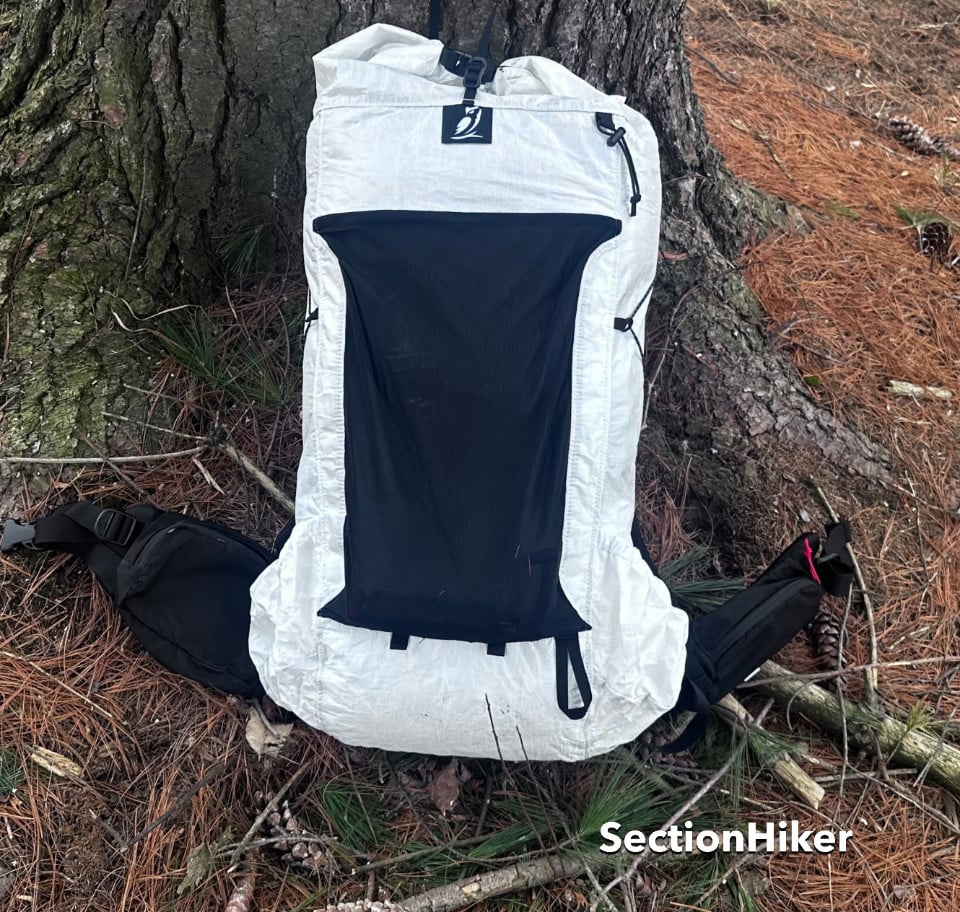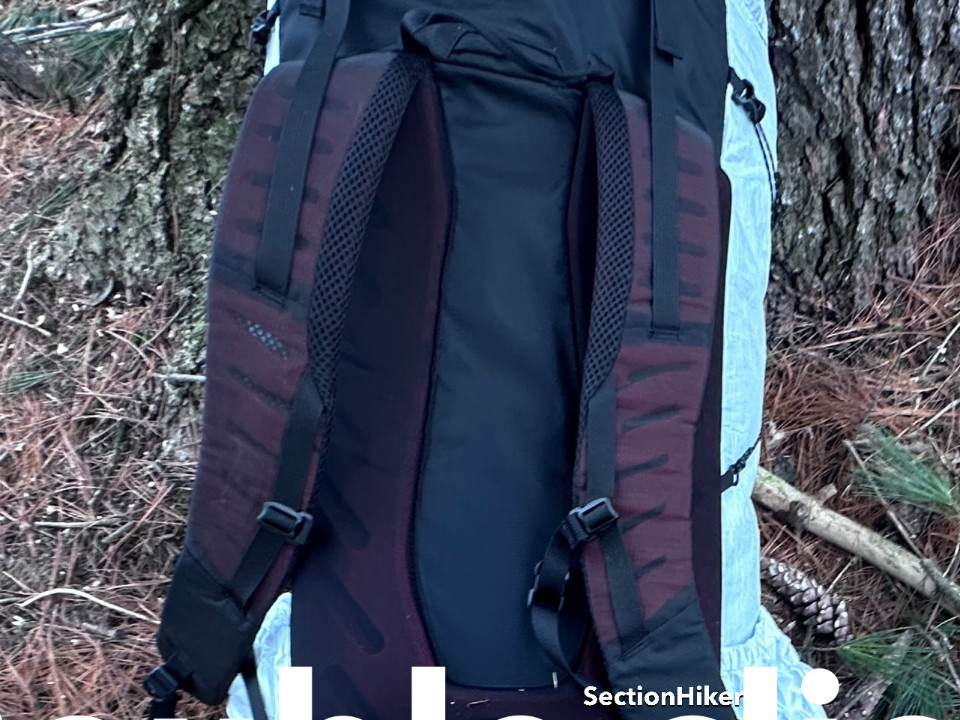The Outdoor Vitals CS40 is an ultralight rolltop backpack made with Ultra fabric that weighs 27 oz. It has two pre-curved carbon fiber stays that act as a frame with a removable hipbelt held in place by velcro. While it is made with Ultra (Ultraweave 200), a waterproof fabric, the pack is not waterproof and has a few quirky features that experienced backpackers will probably shy away from. While the Outdoor Vitals CS40 Backpack is still completely functional, I think that there are much better backpacks available at a similar price point and suggest a few below.
Specs at a Glance
- Price: $368
- Gender: Unisex
- Mfg Weight: 27 oz (Medium torso, medium hipbelt)
- Tested Weight: 28.6 oz (Medium torso, large hipbelt)
- Closed storage: 41-43L (depending on torso length)
- Total storage: 51-53L (depending on torso length)
- Pockets: 5 including 2 on the hip belt.
- Hydration ready: Yes
- Load-lifters: Yes
- Max Recommended Load: 30 lbs
- Material: Challenge UltraWeave 200, Robic nylon, Spacer mesh
- Waterproof Fabric: Yes
- Seam-Sealed: No
- Bear Canister Compatibility: BV425 and BV450 fit horizontally. BV475 and BV500 only fit vertically.
Volume
The Outdoor Vitals CS40 is available in three torso lengths (S, M, L) and three hip belt sizes (S, M, L) (click for size chart). The small torso-length pack has 39L of closed storage in the main pack bag, while the medium and large torso-length packs have 41L. Both pack sizes have an additional 12 liters of external capacity: the two side bottle pockets have 2L each, the two hip belt pockets have 1L each, and the front stretch mesh pocket can hold up to 6L.
The total volume of the pack is sufficient for overnight backpacking or thru-hiking with a lightweight or ultralight load provided you carry highly compressible gear with up to 3-5 days of food.

Backpack Design
The Outdoor Vitals CS40 is a standard rolltop drybag-style backpack with a front mesh pocket. The pack has a removable hydration pocket and a central hydration port between the shoulder straps. There are two side bottle pockets, capable of carrying two side-by-side SmartWater bottles, with elastic running along the top to hold bottles in place which have drain holes at their base. The hipbelt also has two large zippered nylon pockets capable of holding snacks or electronics.
While the main pack bag and side pockets are made with Ultra200 (which is roughly equivalent in durability to Dyneema DCF), the internal seams on the pack are sewn, not seam-taped. The top of the roll top is held closed with velcro, which many backpack manufacturers have moved away from since it is so harmful to woven fleece clothing, including Polartec Alpha pullovers and hoodies.

The rolltop buckles closed on top, not along the sides like a real drybag, a design that leaks in the rain because it can be difficult to tightly roll up an extension collar if it’s not stretched taut. There is also a drain hole at the bottom of the main pack bag, where you’d set the pack down on wet ground. When I inquired about it, it was explained that customers requested it…but that doesn’t necessarily make it a desirable feature on a backpack that will be used in wet weather.

The front stretch mesh pocket has a tight weave and is tear-resistant. The sides of the pocket are reinforced with Ultra fabric which is a nice durability detail. The pocket is well-sized to hold layers and awkward or wet items like a cookpot, a lightweight pump purifier, or a wet tarp.
Backpack Frame and Suspension
The CS40 has two carbon fiber stays as a frame. These are pre-curved and slot into long stay pockets inside the main pack bag that terminate internally on the outside edges of the pack’s lumbar pad. The pack’s external load lifters are anchored to the top of the stays. The wearer is protected from feeling the stays by a horseshoe-shaped piece of foam that also forms the pack’s lumbar pad, running in front of the hipbelt.

The shoulder straps are S-shaped which makes them more comfortable for women’s breasts and men with well-developed chests. The back side of the straps is covered with wicking spacer mesh while the padding has cut-outs to reduce weight and let the straps flow more comfortably over your collarbones and shoulders. The sternum strap runs up and down along webbing straps and is therefore easy to adjust.
However, there are no hosekeeper straps on the outside of the CS40 shoulder straps which is a curious omission on a hydration-ready pack meaning your hose is going to flop around unless you find a way to lash it down. Similarly, there are no good anchor points for hanging external sleeves or pockets on the shoulder straps, save for the load lifters, which would interfere with their function.

If you want to accessorize your pack’s shoulder straps with pockets or bottle sleeves, look for backpacks that have daisy chains sewn to the front of the shoulder straps, like the Hyperlite Mountain Gear Southwest 40 or the Zpacks Arc Haul 40. At a minimum, you need some horizontal attachment points, like a hose keeper strap that you can hang a pocket from. The CS40 doesn’t have any of these.
The hipbelt is quite wide with an easy-to-close central front buckle. The wings are attached to two webbing straps that have a push-forward tightening mechanism, providing the ability to tension the top and bottom halves of the hip belt separately. This is good for people with different hip geometries, including men and women. The hipbelt is backed and padded with wicking spacer mesh and has two zippered pockets.

The hipbelt pockets are quite large and good for storing snacks or valuables. They’re sewn to the hipbelt and not removable. Both pockets have a key clip inside to secure valuables.
Backpack Compression and Attachment Points
The CS40 has two side compression cords whose main function is to secure long items to the side of the pack. The cords attach in three places along the sides of the pack with a single line loc at the top. This makes it difficult to secure a larger object under the cords, like a snowshoe or sleeping pad but is adequate for securing skinny items like a water bottle with a sawyer squeeze filter on top.

I’ve found cord-based compression to be far inferior to webbing straps if what you’re after is to actually compress the main compartment of a backpack to pull it closer to your back. While saving grams by replacing webbing straps with cord-based compression is fashionable, it’s stupid from a functional standpoint and performs poorly in freezing weather or if you need to lash larger items to the side of a pack.
The CS40 comes with a single webbing strap that runs over the rolltop closure and can be used to lash gear to the top of the pack. A Y-strap would be much better, particularly for carrying larger items like a bear canister on top of the pack or snowshoes.

There are two small webbing loops at the base of the front mesh pocket and along the bottom of the pack below the hipbelt where you could string up some cord and cordlocks to hold a sleeping pad or tent body under the pack in a pinch. But those items are so much easier to carry on the sides or top of a pack, that I doubt most people will use them.
Comparable 40L Backpacks
Assessment
The Outdoor Vitals CS40 is an ultralight backpack that weighs 27 oz and is made using a highly durable, waterproof fabric called Ultra. But while the fabric the pack is made with is waterproof, the backpack isn’t, not by a long shot. That’s not a complete showstopper, but it goes to show that the material a pack is made with is often less important than its design, features, and functionality.
The CS40 would be a much better backpack if its seams had been taped to be waterproof, there wasn’t a hole on the bottom of the pack to allow water to flow in, and you could secure the rolltop using buckles along the sides instead of just on top where they will unfurl and admit water. Adding daisy chains or hose keeper loops to the shoulder straps would make it possible to accessorize the pack with external pockets, while the use of more robust compression straps or a top Y-strap would make it easier to lash bulky objects to the pack. Hopefully, some of those features will be added in future revisions to the backpack, but until then, I’d encourage you to look for those features on the other Ultra or Dyneema DCF backpacks listed above that are comparable in cost to the Outdoor Vital CS40 Backpack reviewed here.
